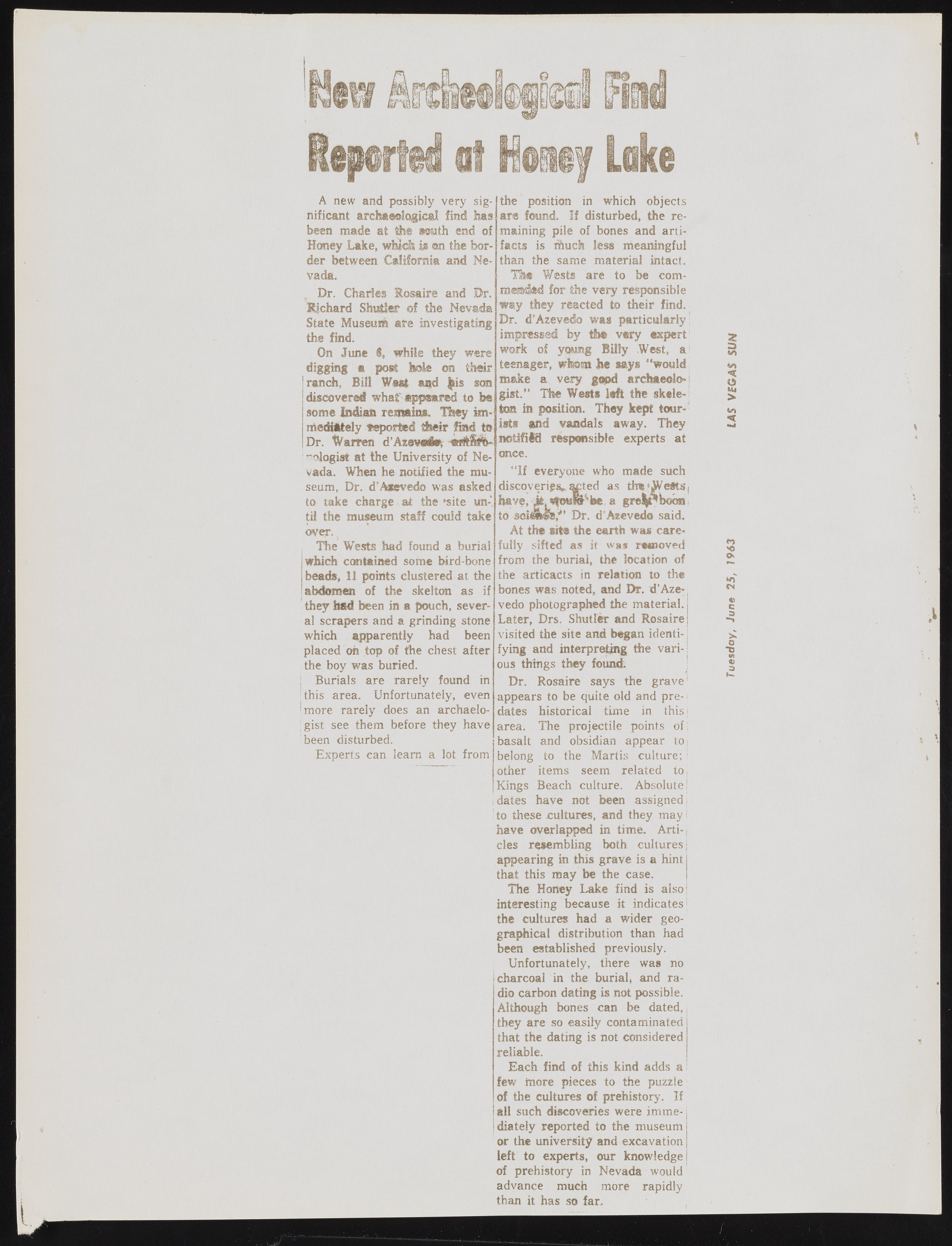Copyright & Fair-use Agreement
UNLV Special Collections provides copies of materials to facilitate private study, scholarship, or research. Material not in the public domain may be used according to fair use of copyrighted materials as defined by copyright law. Please cite us.
Please note that UNLV may not own the copyright to these materials and cannot provide permission to publish or distribute materials when UNLV is not the copyright holder. The user is solely responsible for determining the copyright status of materials and obtaining permission to use material from the copyright holder and for determining whether any permissions relating to any other rights are necessary for the intended use, and for obtaining all required permissions beyond that allowed by fair use.
Read more about our reproduction and use policy.
I agree.Information
Digital ID
Permalink
Details
More Info
Rights
Digital Provenance
Publisher
Transcription
A new and possibly very significant archaeological find has been made at the wrath end of Honey Lake, which m cm the border between California and Nevada. ; Dr. Charles Rosaire and Dr, Richard Shutter ©f the Nevada State Museum ate investigating the find. On June I, while they were digging m post hole on their j ranch, Bill Wta$ and Jlis son discovered whaf appeared to fee some Indian remains. They immediately feported their find to Dr, Warren d’Az$v«i&, l ^ologist at the University of Nevada. When he notified the museum, Dr. d?A*evedo was asked to take charge ? .at the *site until the museum staff could take ewer,. , Tfie Wests had found a burial | which contained some bird-bone (beads, 11 points clustered at the abdomen of the skefion as if they had been in a pouch, several scrapers and a grinding stone which apparently had been placed oh top of the chest after the boy was buried. Burials are rarely found in I this area. Unfortunately, even (more rarely does an archaelo- ; gist see them before they have been disturbed. Experts can learn a lot from the position in which objects are found. If disturbed, the remaining pile of bones and artifacts is rhuch less meaningful than the same material intact. Us# Wests are to be corn-mended for the very responsible way they reacted to their find, ? Dr. d’Azeved© was particularly; impressed by th t vtry expert work of ypyng. Billy .West, a teenager, whom lie says ‘would make a very good arch&eolo*i gist.” The Wests left the skeleton in position. They kept tourists and vandals away. They nofifitB responsible experts at once. ” If everyone who made such discoveries*, acted as th#.fWe§tSj have, a g r e ^ boots to m im m ? ’ Dr. d'Azevedo said. At the sit# the earth was carefully sifted as it w§i removed from the burial, the location of the articacts in relation to the bones was noted, and Dr. d’Aze-vedo photographed the material. | Later, Drs. Shutler and Rosaire! visited the site and began identi- j fying and interpreting the various things they found. t Dr. Rosaire says the grave1 appears to be quite old and predates historical time in this; area. The projectile points of j basalt and obsidian appear to; belong to the Martis culture; { other items seem related to J Kings Beach culture. Absolute! dates have not been assigned; to these cultures, and they may | have overlapped in time. 'Arti-j. das resembling both cultures j appearing in this grave is a hint | that this may be the case. The Honey Lake find is also! interesting because it indicates} the cultures had a wider geographical distribution than had been established previously. Unfortunately, there was no charcoal in the burial* and radio carbon dating is not possible. Although bones can be dated, ! they are so easily contaminated that the dating is not considered reliable. Each find of this kind adds a! few more pieces to the puzzle of the cultures of prehistory. If jail such discoveries were imme-jdiatelv reported to the museum or the university and excavation left to experts, our knowledge of prehistory in Nevada would advance much more rapidly than it has so far. Tuesday, June 25, 1963 LAS VEGAS SUM

